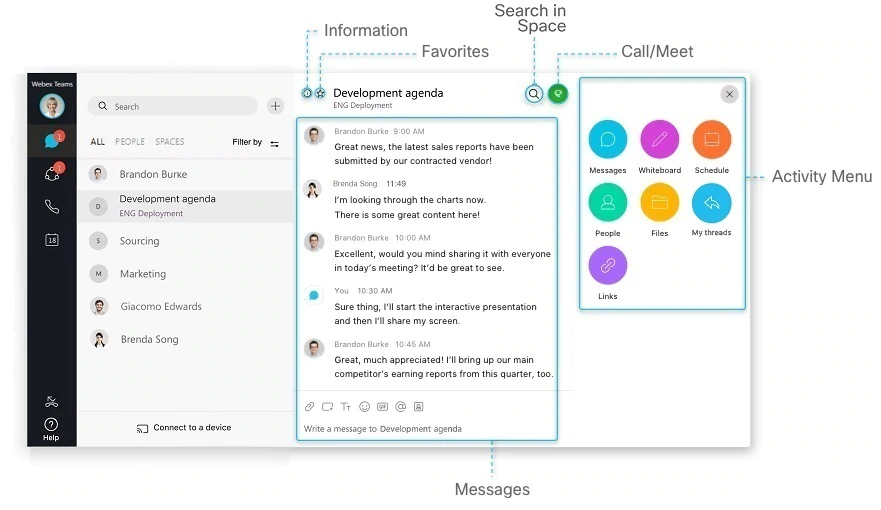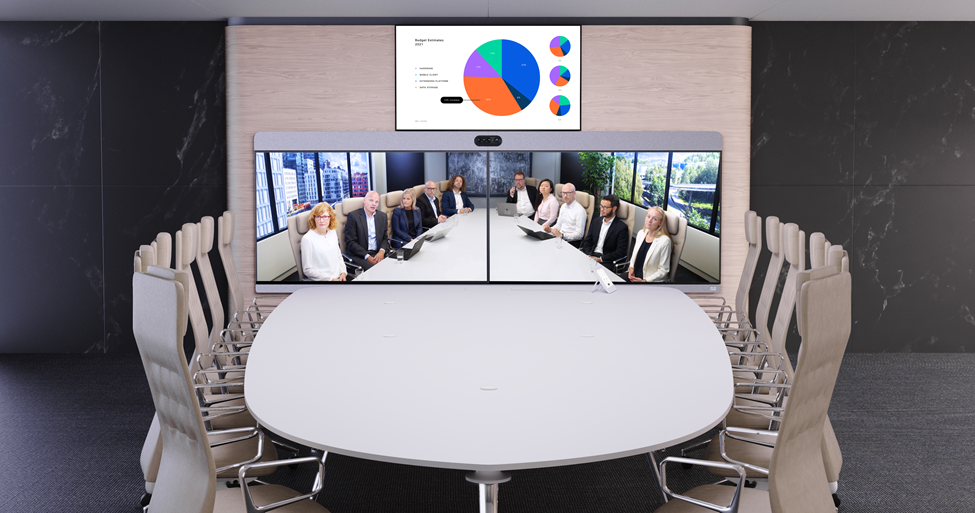Main Capabilities
Webex Space Management handles retention and management needs for Webex Spaces and Direct Room.
Webex keeps your information safe with a broad and holistic approach to security in the cloud. End-to-end encryption means your messages, files and whiteboard drawings are fully encrypted, all the way from your device to your recipients' devices. Control what's shared and keep teamwork private by locking spaces so only moderators can add others.

✔View & search Space information across all the company
Sign in to Webex for group chat, video calling, and sharing documents with your team. It's all backed by Cisco security and reliability. All of your work takes place within spaces in the Cisco Webex teams app. Inside a space, you can send messages, make calls, have video meetings, share files, and whiteboard. You can choose from three types of spaces: people, spaces, and team spaces, depending on why you need to chat.
✔Manage Space users
✔Set manual and automatic retention policies based on conditional Space parameters.
Webex Space Management works seamlessly with Webex Teams and consists on 2 main modules:
- ✔Space Operations
- ✔Retention Policy Engine
Feature List
Space Operations

- •Get a list of all the Webex Spaces -Tag the Spaces for automatic policies, search, and management/governance needs. For example Finance, PII. Tags can be added as needed
- •Add or remove users from spaces without being a member of the space
- •Delete space with all of its content
- •Block Spaces prevent any new content but leave existing content accessible
- •Perform advanced search using multiple parameters:
- •Title
- •Tags
- •Active Directory groups,
- •Scope(internal/ External)
- •Specific external domain members
- •Type (Space / Direct message)
- •Last activity period
- •Space webex classification
Retention Policy Engine
The retention Policy engine allows the company to set multiple conditions for setting retention period based on the following parameters:
- •Tags (set in the space management)
- •Active Directory Groups
- •Last activity date. For example, spaces that have been inactive last 30 days.
- •Scope - whether a Space contains external users.
- •Classification
Webex Classified Spaces
In addition, manual retention period can override the automatic policies
Background
Data Retention Policies
Compliance and internal regulations often require data retention policies. Those usually indicate that after a certain amount of days, data needs to be fully erased. Policies like GDPR require data retention policies.
A common example is companies that need to erase employee or customer data on request or automatically. Also financial firms are usually required to do the same.
Data retention minimizes the risk of a breach or compliance events as less data is exposed in the cloud
Space Management
Webex Teams deployments tenants can sometimes become very large in the number of users and spaces. Company management and compliance teams need visibility of all the Spaces created which is not possible out of the box.
Until this date, there hasn't been a way of providing clear and complete insights of the number of Spaces, their members, their last activity and whether they contain external members.
Other information such as the users, group membership, and external users is critical to handle both compliance and security risks.n
That information can be vital in order to preserve order and prevent security breaches by allowing external users into the incorrect Spaces
Get a Free Trial
Webex Meeting Spaces
Sign-up for a free trial and demo with a SphereShield expert

Get in touch
Har-Hotzvim Hi-Tech Park, Jerusalem, Israel
Space Classification is part of Pro Pack for Cisco Webex Control Hub. For more information, see Pro Pack For Cisco Webex Control Hub.

✔View & search Space information across all the company
Sign in to Webex for group chat, video calling, and sharing documents with your team. It's all backed by Cisco security and reliability. All of your work takes place within spaces in the Cisco Webex teams app. Inside a space, you can send messages, make calls, have video meetings, share files, and whiteboard. You can choose from three types of spaces: people, spaces, and team spaces, depending on why you need to chat.
✔Manage Space users
✔Set manual and automatic retention policies based on conditional Space parameters.
Webex Space Management works seamlessly with Webex Teams and consists on 2 main modules:
- ✔Space Operations
- ✔Retention Policy Engine
Feature List
Space Operations
- •Get a list of all the Webex Spaces -Tag the Spaces for automatic policies, search, and management/governance needs. For example Finance, PII. Tags can be added as needed
- •Add or remove users from spaces without being a member of the space
- •Delete space with all of its content
- •Block Spaces prevent any new content but leave existing content accessible
- •Perform advanced search using multiple parameters:
- •Title
- •Tags
- •Active Directory groups,
- •Scope(internal/ External)
- •Specific external domain members
- •Type (Space / Direct message)
- •Last activity period
- •Space webex classification
Retention Policy Engine
The retention Policy engine allows the company to set multiple conditions for setting retention period based on the following parameters:
- •Tags (set in the space management)
- •Active Directory Groups
- •Last activity date. For example, spaces that have been inactive last 30 days.
- •Scope - whether a Space contains external users.
- •Classification
Webex Classified Spaces
In addition, manual retention period can override the automatic policies
Background
Data Retention Policies
Compliance and internal regulations often require data retention policies. Those usually indicate that after a certain amount of days, data needs to be fully erased. Policies like GDPR require data retention policies.
A common example is companies that need to erase employee or customer data on request or automatically. Also financial firms are usually required to do the same.
Data retention minimizes the risk of a breach or compliance events as less data is exposed in the cloud
Space Management
Webex Teams deployments tenants can sometimes become very large in the number of users and spaces. Company management and compliance teams need visibility of all the Spaces created which is not possible out of the box.
Until this date, there hasn't been a way of providing clear and complete insights of the number of Spaces, their members, their last activity and whether they contain external members.
Other information such as the users, group membership, and external users is critical to handle both compliance and security risks.n
That information can be vital in order to preserve order and prevent security breaches by allowing external users into the incorrect Spaces
Get a Free Trial
Webex Meeting Spaces
Sign-up for a free trial and demo with a SphereShield expert
Get in touch
Har-Hotzvim Hi-Tech Park, Jerusalem, Israel
Space Classification is part of Pro Pack for Cisco Webex Control Hub. For more information, see Pro Pack For Cisco Webex Control Hub.
Space classifications are labels that remind users what they can and can't talk about or share in a space. When a space is classified, a classification label—for example, Public or Company Sensitive—appears in the message area.
Webex Teams Spaces Disappeared
You can add, arrange, and edit space classifications to match your organization's information policies. Users decide which classification to use when they create new spaces.
Set Up Classified Spaces
| 1 | From the customer view at https://admin.webex.com, click Messaging. |
| 2 | Scroll to Webex Teams classified spaces and toggle Enable classified spaces to on. |
| 3 | Click Configure. |
| 4 | For each classification you want to create, click Add, enter a name and description, and then click Next. |
| 5 | Drag and drop the classification names to arrange them in order from the most restricted classification (top of the list) to the least restricted classification (bottom of the list). |
| 6 | To save your changes, click Done. |

